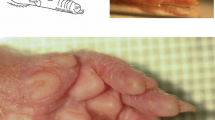Abstract
The Meissner corpuscle is a rapidly-adapting mechanoreceptor in the dermal papillae of digital skin. For an analysis of how the sensory endings detect tissue deformations, an examination of their fine structure and relationships with dermal collagen was carried out in the Japanese monkey, Macaca fuscata, using a combination of three methods: SEM of cell architecture denuded by 6N sodium hydroxide maceration, SEM of collagen networks exposed by a mild alkaline corrosion, and TEM according to a conventional procedure. Observations showed the sensory corpuscles to be represented by a stack of discoid components consisting of flattened axon terminals sandwiched between Schwann cell lamellae, as reported previously. Each corpuscle was entirely covered by a connective tissue capsule, which was linked with the basal aspect of the epidermis by dermal collagen fibers. Margins of the discoid components of the corpuscles were serrated with numerous fine projections of lamellar Schwann cells, which tightly held collagen trabeculae on the inner aspect of the pericorpuscular capsule. Central portions of the discoids, on the other hand, displayed extremely smooth surfaces, which were covered by a thick layer of basal lamina-like matrix. The former portions of the discoids appear susceptible to mechanical deformations of surrounding tissues, while the latter may follow the tissue movements rather slowly because of their indirect linkage with the dermal collagen network. The resulting distortions of the axon endings during dynamic phases of the tissue deformations will be in favor of the generation of rapidly adapting receptor potentials in the sensory corpuscle.
Similar content being viewed by others
References
ANDRES, K. H. & VON DÑRING, M. (1973) Morphology of cutaneous receptors. In Handbook of Sensory Physiology, Vol. 2 (edited by IGGO, A.) pp. 3–28. Berlin, Heidelberg, New York: Springer.
BURGESS, P. R. & PERL, E. R. (1973) Cutaneous mechanoreceptors and nociceptors. In Handbook of Sensory Physiology, Vol. 2 (edited by IGGO, A.) pp. 29–78. Berlin, Heidelberg, New York: Springer.
BYERS, M. R. (1985) Sensory innervation of periodontal ligament of rat molars consists of unencapsulated Ruffinilike mechanoreceptors and free nerve endings. Journal of Comparative Neurology 231, 500–518.
CASTANO, P. (1974) Further observations on the Wagner-Meissner's corpuscle of man. An ultrastructural study. Journal of Submicroscopic Cytology 6, 323–337.
CASTANO, P. & VENTURA, R. G. (1978) The Meissner's corpuscle of the green-monkey (Cercopithecus aethiops L.). I. The organization of the nervous component. Journal of Submicroscopic Cytology 10, 327–344.
CASTANO, P. & VENTURA, R. G. (1979) The Meissner's corpuscle of the green monkey (Cercopithecus aethiops L.). II. The connective tissue component. Some considerations from a functional standpoint. Journal of Submicroscopic Cytology 11, 185–191.
CASTANO, P., RUMIO, C., MORINI, M., MIANI, A. JR. & CASTANO, S. M. (1995) Three-dimensional reconstruction of the Meissner corpuscle of man, after silver impregnation and immunofluorescence with PGP 9.5 antibodies using confocal scanning laser microscopy. Journal of Anatomy 186, 261–270.
CAUNA, N. (1956a) Nerve supply and nerve endings in Meissner's corpuscles. American Journal of Anatomy 99, 315–350.
CAUNA, N. (1956b) Structure and origin of the capsule of Meissner's corpuscle. Anatomical Record 124, 77–93.
CAUNA, N. & ROSS, L. L. (1960) The fine structure of Meissner's touch corpuscles of human fingers. Journal of Biophysical and Biochemical Cytology 8, 467–482.
CHOUCHKOV, C. N. (1973) Further observations of the fine structure of Meissner's corpuscules in human digital skin and rectum. Zeitschrift für Mikroskopisch-anatomische Forschung 87, 33–45.
HALATA, Z. (1975) The mechanoreceptors of the mammalian skin. Ultrastructure and morphological classification. Advances in Anatomy, Embryology and Cell Biology 50, 5–77.
HASHIMOTO, K. (1973) Fine structure of the Meissner corpuscle of human palmar skin. Journal of Investigative Dermatology 60, 20–28.
JOHANSSON, R. S. & VALLBO, Å. B. (1983)Tactile sensory coding in the glabrous skin of the human hand. Trends in Neurosciences, 27–32.
IDE, C. (1976) The fine structure of the digital corpuscle of the mouse toe pad, with special reference to nerve fibers. American Journal of Anatomy 147, 329–356.
IDE, C. (1982) Histochemical study of lamellar cell development of Meissner corpuscles. Archivum Histologicum Japonicum 45, 83–97.
IDE, C. (1983) Nerve regeneration and Schwann cell basal lamina: observations of the long-term regeneration. Archivum Histologicum Japonicum 46, 243–257.
IDE, C. (1987) Role of extracellular matrix in the regeneration of a pacinian corpuscle. Brain Research 413, 155– 169.
MUNGER, B. L. & IDE, C. (1988) The structure and function of cutaneous sensory receptors. Archives of Histology and Cytology 51, 1–34.
MUNGER, B. L., PAGE, R. B. & PUBOLS, B. H. JR. (1979) Identification of specific mechanosensory receptors in glabrous skin of dorsal root ganglionectomized primates. Anatomical Record 193, 630–631.
OHTANI, O. (1987) Three-dimensional organization of the connective tissue fibers of the human pancreas: A scanning electron microscopic study ofNaOHtreated tissues. Archivum Histologicum Japonicum 50, 557–566.
PEASE, D. C. & PALLIE, W. (1959) Electron microscopy of digital tactile corpuscles and small cutaneous nerves. Journal of Ultrastructure Research 2, 352–365.
SCHOULTZ, T. W. & SWETT, J. E. (1972) The fine structure of the Golgi tendon organ. Journal of Neurocytology 1, 1–26.
SCHOULTZ, T. W. & SWETT, J. E. (1974) Ultrastructural organization of the sensory fibers innervating the Golgi tendon organ. Anatomical Record 179, 147–162.
TAKAHASHI-IWANAGA, H. (2000) Three-dimensional microanatomy of longitudinal lanceolate endings in rat vibrissae. Journal of Comparative Neurology 426, 259–269.
TAKAHASHI-IWANAGA, H. (2001) Three-dimensional microanatomy of mechanoreceptors and their possible mechanism of sensory transduction. Italian Journal of Anatomy and Embryology 106 (Suppl. 1), 481–487.
TAKAHASHI-IWANAGA, H. & FUJITA, T. (1986) Application of anNaOHmaceration method to a scanning electron microscopic observation of Ito cells in the rat liver. Archivum Hisotologicum Japonicum 49, 349–357.
TAKAHASHI-IWANAGA, H., MAEDA, T. & ABE, K. (1997) Scanning and transmission electron microscopy of Ruffini endings in the periodontal ligament of rat incisors. Journal of Comparative Neurology 389, 177–184.
Author information
Authors and Affiliations
Corresponding author
Rights and permissions
About this article
Cite this article
Takahashi-Iwanaga, H., Shimoda, H. The three-dimensional microanatomy of Meissner corpuscles in monkey palmar skin. J Neurocytol 32, 363–371 (2003). https://doi.org/10.1023/B:NEUR.0000011330.57530.2f
Issue Date:
DOI: https://doi.org/10.1023/B:NEUR.0000011330.57530.2f




